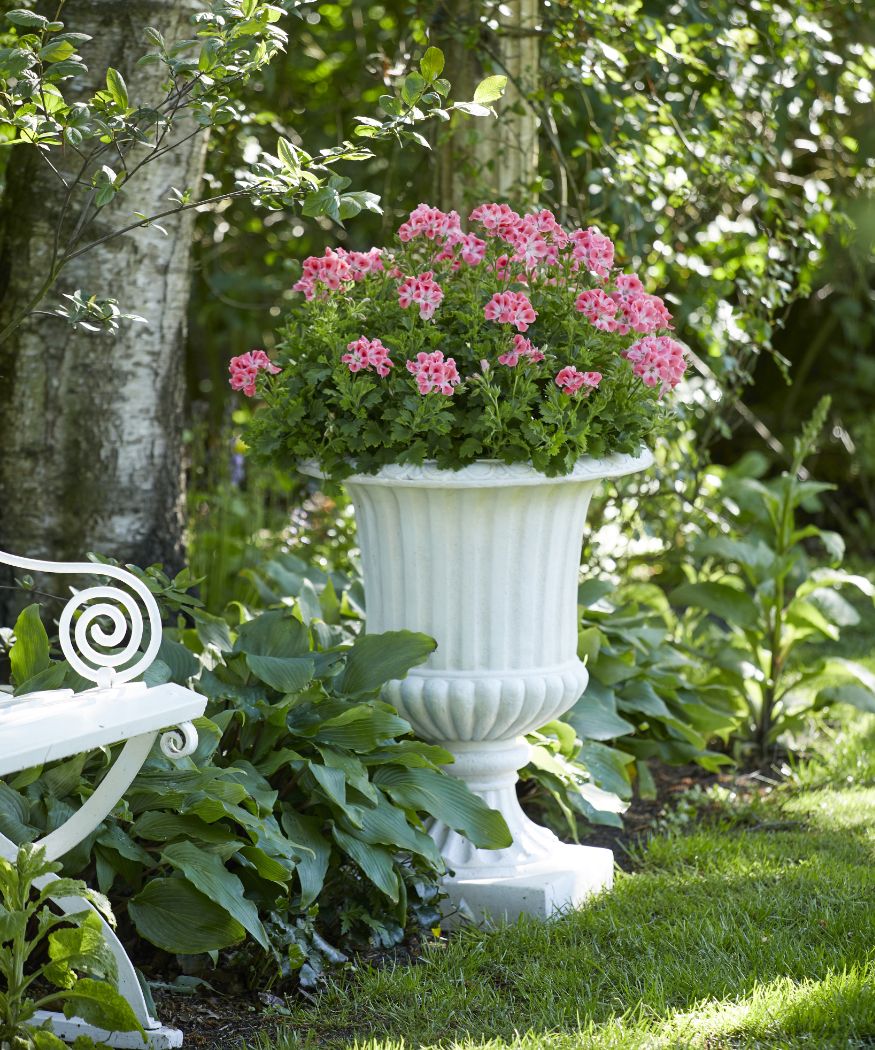When Cold Sophia, the last of the Ice Saints, has come and gone in mid-May and the blooming period of spring harbingers such as lilies of the valley, hyacinths, primroses and tulips has come to an end, it’s time to invite the queen of all summer plants back into our home gardens. Due to their beautiful colours, abundant flowering and easy care, it’s hard to imagine a summer garden or balcony oasis without geraniums. To make sure this South African sun-worshipper can thrive, it needs a spot with full sun or at most partial shade. The experts from Pelargonium for Europe explain what is required to ensure a successful start into the planting season.
How to make geraniums feel at home in balcony boxes
Balcony boxes are without a doubt the most-used containers for geraniums. With the following planting instructions, they will become the perfect home for your geraniums. To avoid waterlogging, it’s advisable to first spread layer of clay shards, aerated clay balls or similar material in the bottom of the balcony boxes, to prevent the drainage holes from getting clogged with substrate. With new containers it’s sometimes necessary to cut these holes open before planting. Another alternative is to use self-watering planters, which come with a special granulate mix that is used as a bottom layer instead of the drainage material.
Then fill the balcony box to about three-quarters with fresh geranium soil. Press the substrate firmly up around the insides of the box with your hands to ensure that it doesn’t pull away from the sides. Geraniums require feeding in the form of fertilizer in order to flower abundantly. As they have high nutrient requirements, they need fertilizing throughout the summer. For best results, sprinkle the soil with slow-release fertilizer in a dosage in keeping with the manufacturer’s instructions and mix it into the top layer. Alternatively, you can use a special geranium potting mix that already contains slow-release fertilizer.
Before planting the geraniums, soak the root bales in a bucket of lukewarm water. The ideal space between plants is at least 20 centimetres, as geraniums will grow and spread out in all directions over the course of the summer. The root bale should be just below the surface of the soil. If planted too deep, the geraniums will not grow as well and if the root bale protrudes, more watering is required. If necessary, add some more substrate and press down gently, leaving a watering trough of about two centimetres.
Important: Even in a self-watering pot the plants must be watered from the top during the first few weeks until the plant has established more roots.
How to grow perfect geraniums in planters and hanging pots
In principle, preparing large planters and hanging pots is the same procedure as with balcony boxes:
look for a suitable spot, prepare the container with proper drainage, add potting soil and fertilizer. When selecting the pot ensure that it’s deep enough to give the plants enough room to grow. Here again, the rule of thumb is to leave at least 20 centimetres between each plant. The best choice for all kinds of hanging pots are cascading ivy geraniums. Generally speaking, geraniums in smaller and hanging pots need to be watered more often than those in big balcony boxes, as containers with less volume have smaller water reservoirs. Particularly on hot days and in periods of draught the plants should therefore be watered in small amounts twice a day.
Geraniums in flowerbeds
Basically, geraniums can also be planted directly in flowerbeds. The most suitable location for them is in your perennial bed. If you’re thinking about overwintering your geraniums indoors at the end of the season, you can also set them in the ground in their pots. This makes it easier to dig them up again in the fall.
Beautiful flowers well into autumn: a few care tips
With a few simple tips, you can make sure these summer beauties flower vigorously well into autumn. So after a few weeks, even if a slow-release fertilizer was used when planting, liquid fertilizer should be added to the watering can once a week. It’s also advisable to deadhead spent flowers on a regular basis. If you want to keep a uniform look, especially in balcony boxes it also makes sense to occasionally prune back any plants that are growing faster than their neighbours, which also gives the others a chance to catch up.
 English
English Dansk
Dansk Deutsch
Deutsch English
English Español
Español Français
Français Hrvatski
Hrvatski Italiano
Italiano Magyar
Magyar Nederlands
Nederlands Norsk
Norsk Polski
Polski Română
Română Slovenski
Slovenski Slovenský
Slovenský Suomalainen
Suomalainen Svenska
Svenska Česky
Česky Ελληνική
Ελληνική Български
Български